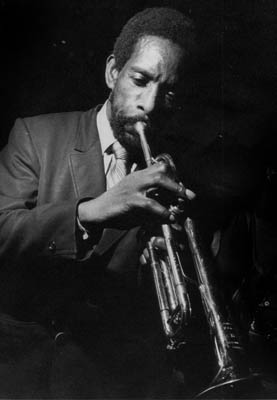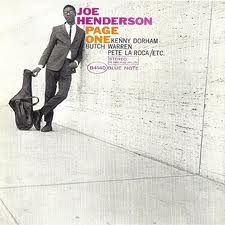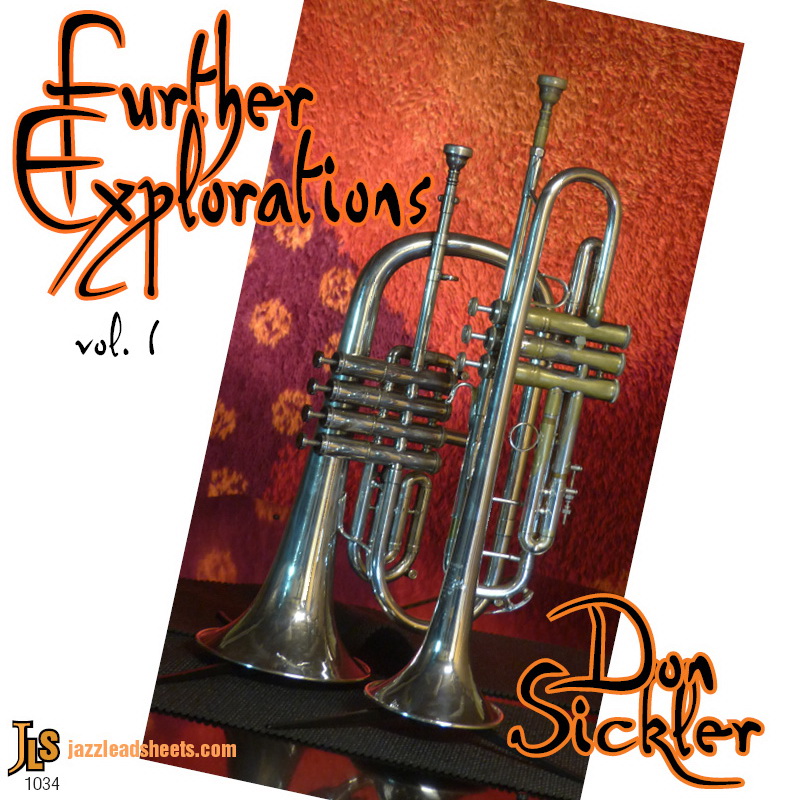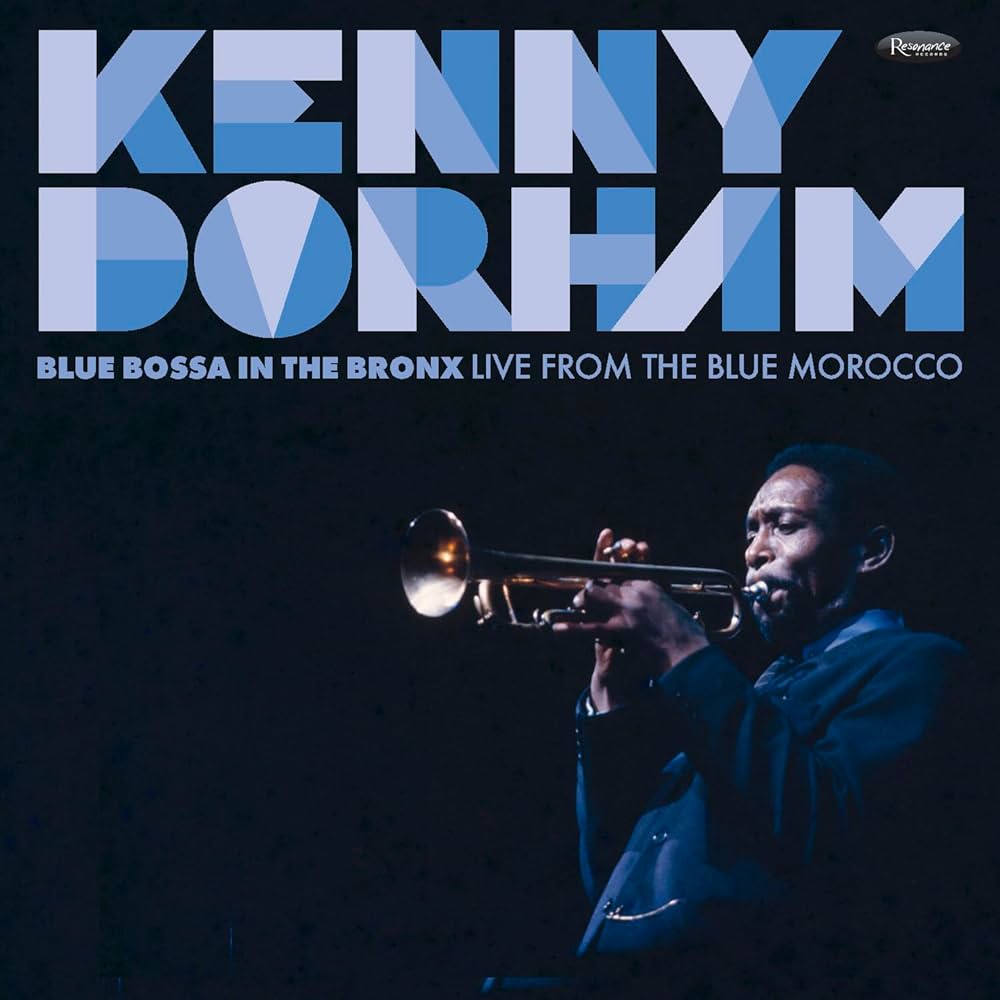Blue Bossa – Kenny Dorham
The Kenny Dorham classic—just as Kenny heard it. Did you know it was written around a bass line? Only jazzleadsheets.com has the lead sheet exactly as Kenny originally wrote it. Lead sheets and second parts available, and now with a Minus You bass line track.
- Recording: Joe Henderson - Page One
- Recorded on: June 3, 1963
- Label: Blue Note (BLP 4140)
- Concert Key: C minor
- Vocal Range: , to
- Style: Latin (Bossa)
- Trumpet - Kenny Dorham
- Tenor Sax - Joe Henderson
- Piano - McCoy Tyner
- Bass - Butch Warren
- Drums - Pete LaRoca
0:00
0:00
Buy MP3
Video
- Chick Corea & Chucho Valdéz Piano Duo
- J.J. Johnson, trombone; Ralph Moore, tenor sax; Renee Rosnes, piano, Rufus Reid, bass; Billy Drummond, drums. Umbria Jazz 1993
- Don Sickler, trumpet; Bobby Watson, alto sax; Shigeharu Mukai, trombone; Bobby Hutcherson, vibes; Don Pullen, piano; Cameron Brown, bass; Lewis Nash, drums. Mt. Fuji Jazz Festival
- Description
- Historical Notes
- Solos
- Piano Corner
- Bass Corner
- Drum Corner
- Guitar Corner
- Inside & Beyond
- Minus You
This is Kenny Dorham's "jazz standard." Many of you may feel you know it, and maybe you've even performed it. However, you may not be aware of the real magic of the composition: it's written around a bass line. For Kenny, the bass line was a very important part of the composition. If you listen carefully to our excerpt, which starts at the beginning of the melody, you'll hear the bass line. The actual recording starts with an eight-measure introduction, where bassist Butch Warren sets up the melody with four repetitions of the two-measure bass pattern. If you knew the composition but weren't aware of this bass line before, you're in for a real treat when you play the melody with K.D.'s bass line.
The C treble clef lead sheet includes the bass line on a separate staff under both the melody and the shout chorus, so you can see how they fit together. The other editions (B♭, E♭, C bass clef and all second parts) have only the melody line and the chord changes with bass line rhythms shown under the staff. Bass players, as well as anyone else wanting to see the entire bass line, should get the C treble clef edition.
All of our editions also contain Kenny's shout chorus. The shout chorus is constructed around the same bass line.
The C treble clef lead sheet includes the bass line on a separate staff under both the melody and the shout chorus, so you can see how they fit together. The other editions (B♭, E♭, C bass clef and all second parts) have only the melody line and the chord changes with bass line rhythms shown under the staff. Bass players, as well as anyone else wanting to see the entire bass line, should get the C treble clef edition.
All of our editions also contain Kenny's shout chorus. The shout chorus is constructed around the same bass line.
"Page One" was recorded at the legendary Van Gelder Studio in Englewood Cliffs.
Don Sickler recalls,"I had many wonderful conversations with Joe Henderson about Kenny Dorham. Joe and Kenny worked closely together for many years and made quite a few albums together.
"Joe said he was always inspired by Kenny's writing, especially how Kenny wrote for the rhythm section. K.D.'s concept of constructing a melody around a bass line was something that Joe took to heart and used in his own writing. Many aren't aware that the melody of Joe Henderson's "standard," Recorda Me, also on the "Page One" album, is written around a bass line. "
Joe's first recording session was two months earlier, for Kenny Dorham's "Una Mas" album. That album featured another Dorham title, Una Mas.
Jazz guitarist Kenny Burrell wrote and recorded a lyric to Blue Bossa, called It's No Time To Be Blue.
Don Sickler recalls,"I had many wonderful conversations with Joe Henderson about Kenny Dorham. Joe and Kenny worked closely together for many years and made quite a few albums together.
"Joe said he was always inspired by Kenny's writing, especially how Kenny wrote for the rhythm section. K.D.'s concept of constructing a melody around a bass line was something that Joe took to heart and used in his own writing. Many aren't aware that the melody of Joe Henderson's "standard," Recorda Me, also on the "Page One" album, is written around a bass line. "
Joe's first recording session was two months earlier, for Kenny Dorham's "Una Mas" album. That album featured another Dorham title, Una Mas.
Jazz guitarist Kenny Burrell wrote and recorded a lyric to Blue Bossa, called It's No Time To Be Blue.
Essential Bass (Butch Warren)
Many of trumpeter/composer Kenny Dorham's compositions contain specific parts for each member of the ensemble, making the whole greater than the sum of its parts. The lines interact with with the underlying harmonies and rhythms.
This composition is written around a bass line which is shown in the C treble clef lead sheet. For Kenny, the bass line was a very important part of the composition. The eight-measure introduction sets up the melody with four repetitions of the two-measure bass pattern.
Bass players should purchase the C treble clef (with Bass) lead sheet.
Many of trumpeter/composer Kenny Dorham's compositions contain specific parts for each member of the ensemble, making the whole greater than the sum of its parts. The lines interact with with the underlying harmonies and rhythms.
This composition is written around a bass line which is shown in the C treble clef lead sheet. For Kenny, the bass line was a very important part of the composition. The eight-measure introduction sets up the melody with four repetitions of the two-measure bass pattern.
Bass players should purchase the C treble clef (with Bass) lead sheet.
Chord Melody Arrangement by Bruce Acosta:
With this chord melody arrangement, you can perform this iconic Kenny Dorham tune on guitar. Each melody note is harmonized utilizing a wide range of voicings—basic minor sixth voicings, diminished passing chords, quartal voicings and more.
This is a great resource for intermediate guitarists looking to expand their harmonic vocabulary and develop their facility moving between chord shapes.
A version with tablature is available for guitarists less familiar with standard notation.
The standard notation version is available in two octaves.
With this chord melody arrangement, you can perform this iconic Kenny Dorham tune on guitar. Each melody note is harmonized utilizing a wide range of voicings—basic minor sixth voicings, diminished passing chords, quartal voicings and more.
This is a great resource for intermediate guitarists looking to expand their harmonic vocabulary and develop their facility moving between chord shapes.
A version with tablature is available for guitarists less familiar with standard notation.
The standard notation version is available in two octaves.
Related Songs
Email Send Blue Bossa to a friend
Send this page to a friend via email. Add your name or email in the first field. In the second, add one or more email addresses, separated by a comma.
- Recording: Don Sickler - Further Explorations Vol. 1
- Recorded on: June 28, 2018
- Label: jazzleadsheets.com (JLS 1034)
- Concert Key: C minor
- Vocal Range: , to
- Style: Latin (Bossa)
- Trumpet - Don Sickler
- Bass - Jack Aylor
Video
- Description
- Historical Notes
- Solos
- Piano Corner
- Bass Corner
- Drum Corner
- Guitar Corner
- Inside & Beyond
- Minus You
The main reason for this recording, aside from the fun I have playing with a good bass player, is that it also emphasizes the bass line, which K.D. created first, before creating the melody. Kenny first wrote the bass line—a two-measure rhythmic figure. He keeps the rhythmic elements of the figure consistent as the chord progression evolves through the 16-measure composition. Blue Bossa has become an important jazz standard, and the basically simple melody has therefore been put through many variations. Played with K.D.'s bass line, it clearly defines Kenny's original rhythmic direction for the melody.
The online Lord Discography currently (as of 6/2/2024) lists 279 recordings. of Blue Bossa. If you search it on YouTube, you'll also find a lot of concert performances as well as inexperienced musician performances.
In my role as publisher, I always try to present the melody as the composer originally wrote it. I feel that's the best way to present the melody to a new musician. Notating Blue Bossa was therefore very simple for me to show Kenny's original melody, since his bass line dictates the rhythms of the melody.
As you can read in the Historical Notes for my own The Forgotten Line, Joe Henderson told me K.D. came up with an interesting idea when the two were discussing writing music for Joe's "Page One." project. Kenny suggested that each of them come up with an interesting bass line first, then create a composition over it. Not a bad idea! The result: each man created and recorded for the first time their jazz standards: Kenny Dorham's Blue Bossa,, and Joe Henderson's Recorda-Me.
In my role as publisher, I always try to present the melody as the composer originally wrote it. I feel that's the best way to present the melody to a new musician. Notating Blue Bossa was therefore very simple for me to show Kenny's original melody, since his bass line dictates the rhythms of the melody.
As you can read in the Historical Notes for my own The Forgotten Line, Joe Henderson told me K.D. came up with an interesting idea when the two were discussing writing music for Joe's "Page One." project. Kenny suggested that each of them come up with an interesting bass line first, then create a composition over it. Not a bad idea! The result: each man created and recorded for the first time their jazz standards: Kenny Dorham's Blue Bossa,, and Joe Henderson's Recorda-Me.
CLIP Exclusive Minus You audio track, bass alone The minus melody track is played by bass alone. There is no count off, since the bass starts with with an 8-measure intro [the 2-measure bass figure played four times.]
Bass alone track format:
-- intro (8 measures of bass)
-- play melody with pickup
-- repeat melody with 2nd ending to solos
-- solo for 4 choruses
-- play shout chorus with repeat
-- play out melody with repeat to coda
-- improvise over coda [ritard in the 6th measure into downbeat hold [7th measure]
Bass alone track format:
-- intro (8 measures of bass)
-- play melody with pickup
-- repeat melody with 2nd ending to solos
-- solo for 4 choruses
-- play shout chorus with repeat
-- play out melody with repeat to coda
-- improvise over coda [ritard in the 6th measure into downbeat hold [7th measure]
Related Songs
Email Send Blue Bossa to a friend
Send this page to a friend via email. Add your name or email in the first field. In the second, add one or more email addresses, separated by a comma.
- Recording: Kenny Dorham - Blue Bossa In The Bronx
- Recorded on: 1967
- Label: Resonance Records (HCD 2072)
- Concert Key: C minor
- Vocal Range: , to
- Style: Latin (Bossa)
- Trumpet - Kenny Dorham
- Alto Sax - Sonny Red
- Piano - Cedar Walton
- Bass - Paul Chambers
- Drums - Denis Charles
- Description
- Historical Notes
- Solos
- Piano Corner
- Bass Corner
- Drum Corner
- Guitar Corner
- Inside & Beyond
- Minus You
The lead sheet (melody) for this version is the same as the original "Page One” recording. The difference between the two recordings is the way the rhythm section comps for the melody. This newly-released 1967 Kenny Dorham recording starts with a solo piano intro which sets up a more conventional 2-feel Latin groove under the melody instead of Kenny's original written-out two-measure repeating bass pattern. The new 2-feel Latin is faster than the original (quarter note = ca. 208). Note that the phrasing of the melody is exactly the same, confirming that this is the correct phrasing Kenny wants for the melody, which his "Page One" recording so clearly defines. The same shout chorus (two times) sets up the out melody. Kenny's phrasing of the shout melody now has the two inside 8th notes in each measure tongued short with the new rhythm section feel. It's sure great to get to hear Kenny play Blue Bossa in a live gig situation.
Without the original two-measure bass line, the changes are slightly different: the fourth measure stays on F minor instead of going to B♭7.
PERFORMANCE SUGGESTIONS for Blue Bossa (Don Sickler):
"If you go to YouTube and check out various great artists playing the melody of Blue Bossa, when the melody is played by a single instrument, you'll hear a lot of different rhythmic interpretations, which I feel is great. It's a 'standard' which everyone should know, so playing the melody alone, you should play it as you hear it at that moment in time.
"However, it's also a big jam session favorite, so what do you do if you're one of the melody players thrust on the stage to play Blue Bossa?
"To explain what I'm driving at, check out what happened when I was put into this very position in a 1989 Mt. Fuji 3-horn front line feature jam session. It was a great comping rhythm section: Bobby Hutcherson (vibes), Don Pullen (piano), Cameron Brown (bass) and Lewis Nash (drums) providing a great and what I call inspiring, "athletic" 2-feel Latin comp. So what happens: I try to play the first phrase of the melody K.D.'s original way, but I'm not assertive, and horn chaos starts to set in. All three of us then try to come up with a solution. By the eighth measure of the melody we settled on a more down beat-oriented version. The second melody chorus then turns into using downbeats in each four measure phrase: melody on the 4th beat of measure 2, then in measure 3, the melody starts on the downbeat and the next note is on the 3rd beat. I always felt this way of playing the melody was too stiff and lacking the energy of K.D.'s syncopations: check out the video above for our Mt. Fuji performance.
"Now hearing Kenny's second recording, and watching the Mt. Fuji video, I've learned an important lesson. The next time Blue Bossa comes up for me in a jam session, I'm going to be assertive and hammer down K.D.'s syncopated melody treatment, and see if I can get everyone else in the front line to go with me!"
A transcription of Kenny Dorham’s solo is available; click on Solos for more details.
Without the original two-measure bass line, the changes are slightly different: the fourth measure stays on F minor instead of going to B♭7.
PERFORMANCE SUGGESTIONS for Blue Bossa (Don Sickler):
"If you go to YouTube and check out various great artists playing the melody of Blue Bossa, when the melody is played by a single instrument, you'll hear a lot of different rhythmic interpretations, which I feel is great. It's a 'standard' which everyone should know, so playing the melody alone, you should play it as you hear it at that moment in time.
"However, it's also a big jam session favorite, so what do you do if you're one of the melody players thrust on the stage to play Blue Bossa?
"To explain what I'm driving at, check out what happened when I was put into this very position in a 1989 Mt. Fuji 3-horn front line feature jam session. It was a great comping rhythm section: Bobby Hutcherson (vibes), Don Pullen (piano), Cameron Brown (bass) and Lewis Nash (drums) providing a great and what I call inspiring, "athletic" 2-feel Latin comp. So what happens: I try to play the first phrase of the melody K.D.'s original way, but I'm not assertive, and horn chaos starts to set in. All three of us then try to come up with a solution. By the eighth measure of the melody we settled on a more down beat-oriented version. The second melody chorus then turns into using downbeats in each four measure phrase: melody on the 4th beat of measure 2, then in measure 3, the melody starts on the downbeat and the next note is on the 3rd beat. I always felt this way of playing the melody was too stiff and lacking the energy of K.D.'s syncopations: check out the video above for our Mt. Fuji performance.
"Now hearing Kenny's second recording, and watching the Mt. Fuji video, I've learned an important lesson. The next time Blue Bossa comes up for me in a jam session, I'm going to be assertive and hammer down K.D.'s syncopated melody treatment, and see if I can get everyone else in the front line to go with me!"
A transcription of Kenny Dorham’s solo is available; click on Solos for more details.
Don Sickler: “I was elated when I heard there was another (1967) recording of Kenny Dorham playing Blue Bossa. I wish there were more recordings of Kenny playing his universal jazz standard, but if only two surface, I'm thankful for that.
"Today (4/11/2025) the Lord Discography lists 285 jazz recordings of Kenny Dorham's Blue Bossa, so obviously it's a big time jazz standard. On many of these recordings, the melody has been rhythmically explored in different ways. I went into depth about the K.D. history of the creation of the melody in the notes for our other two recordings shown on the Blue Bossa song page, explaining that Kenny wrote the bass line first, before the melody.
"Now, finally, we have a second recording of Kenny Dorham playing the melody. This time the rhythm section plays in what I call a more conventional 2-feel Latin groove. Kenny, however, phrases the melody with the same syncopations of his original recording, which had Kenny's written two-measure repeating bass pattern. Here's Kenny playing the melody over the original recording of Blue Bossa pageone>, and now Kenny playing his melody over the more conventional 2-feel Latin rhythm section (bronx>). The fact that Kenny plays the same syncopations certainly tells me that this is the way he heard his Blue Bossa melody."
This newly-released album was recorded three years after Kenny’s last studio session as a leader. Another live recording from the previous year (check out Jung Fu) also features Kenny alongside Sonny Red and Cedar Walton, with John Ore on bass and Hugh Walker on drums.
"Today (4/11/2025) the Lord Discography lists 285 jazz recordings of Kenny Dorham's Blue Bossa, so obviously it's a big time jazz standard. On many of these recordings, the melody has been rhythmically explored in different ways. I went into depth about the K.D. history of the creation of the melody in the notes for our other two recordings shown on the Blue Bossa song page, explaining that Kenny wrote the bass line first, before the melody.
"Now, finally, we have a second recording of Kenny Dorham playing the melody. This time the rhythm section plays in what I call a more conventional 2-feel Latin groove. Kenny, however, phrases the melody with the same syncopations of his original recording, which had Kenny's written two-measure repeating bass pattern. Here's Kenny playing the melody over the original recording of Blue Bossa pageone>, and now Kenny playing his melody over the more conventional 2-feel Latin rhythm section (bronx>). The fact that Kenny plays the same syncopations certainly tells me that this is the way he heard his Blue Bossa melody."
This newly-released album was recorded three years after Kenny’s last studio session as a leader. Another live recording from the previous year (check out Jung Fu) also features Kenny alongside Sonny Red and Cedar Walton, with John Ore on bass and Hugh Walker on drums.
CLIP Kenny Dorham’s solo on this live recording is seven choruses long. This exquisite solo is full of the trademarks of K.D.’s style. Though he takes many approaches to the changes, this is a well-structured solo with a clear overarching form. In many choruses he begins with a simple and memorable theme, developing it into more complex lines in the second half of the chorus and switching to another theme for the next chorus. Especially at the beginnings of these choruses, he really explores the infinite melodic possibilities within this simple chord progression.
Related Songs
Email Send Blue Bossa to a friend
Send this page to a friend via email. Add your name or email in the first field. In the second, add one or more email addresses, separated by a comma.

Kenny Dorham
August 30, 1924 – December 15, 1972
August 30, 2025, is Kenny Dorham's 101st birthday: jazzleadsheets.com has added many new K.D. compositions. Jazz At Lincoln Center has dedicated three late-night sets to Kenny's music, played with love by young musicians who want his music to live on. Join in, play K.D. music! Read more...
There was a problem.
...






